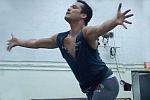 Shadows off the beaten path
Shadows off the beaten pathWATER FLOWING TOGETHER | WHERE IN THE WORLD IS OSAMA BIN LADEN
< < D O C S > >
last update 17.Apr.08
See also: SHADOWS FILM FESTIVAL
 R E V I E W B Y R I C H C L I N E
R E V I E W B Y R I C H C L I N E
with Ita Buttrose, Neal Blewett, Bill Whittaker, Bill Bowtell, Julie Bates, Stephen Allkins, Basil Donovan, Alex Wodak, David Penington, Garrett Prestage, Jenny Ross, Fred Nile
 release Aus Dec.07 tv,
release Aus Dec.07 tv, UK Mar.08 llgff
07/Australia 57m

 This lively documentary examines how Australia took a markedly different approach to the emergence of HIV and Aids in the 1980s. There's perhaps a bit too much back-slapping, but most governments could still learn from this.
This lively documentary examines how Australia took a markedly different approach to the emergence of HIV and Aids in the 1980s. There's perhaps a bit too much back-slapping, but most governments could still learn from this.
The first Aids diagnosis in Australia was in 1982, when medical workers had no idea what they were seeing, and they certainly never connected it with local communities that were most at risk: prostitutes, drug users and those indulging in promiscuous gay sex, all of which were illegal in Australia at the time. But instead of moralising about the behaviour to consolidate their own power (like Reagan and Falwell in America), Aussie officials opted for prevention, enlisting "poofters, junkies and whores" to help contain the virus.
Along with terrific archive footage, a wide range of people tell their extremely personal stories of struggle against what seemed at first like an immovable system. Their challenge was to end the ignorant apathy of the general public (they used a series of shocking "grim reaper" adverts that offended almost everyone, which was the point). They also had to make condoms something any responsible hooker or gay man would use, and clean needles something any responsible official would distribute.
By putting the discussion into the mainstream, the government had to act; and by legalising brothels, opening clinics and giving away needles and condoms, Australia's HIV/Aids rates fell more quickly than anywhere else in the world. Meanwhile in America, where the government still won't fund needle or condom programmes, rates of infection are rising. For example, in Australia, the incidence of infection among drug users is now 1 percent, while in the USA it's 20 percent. These kinds of statistics are impressive; even if they're exaggerated, they make a powerful point.
With a lucid, fast-paced style, the filmmakers explore the issue from every conceivable angle, looking at all of the theories, stigmas and realities. It's extremely telling that the workers in Australia realised very quickly that they would never stop the spread of the virus if they let it become a political fight. And the way newspaper editors, activists and government officials went out on a limb to address the issue is truly inspiring.
16.Mar.08 llgff
 R E V I E W B Y R I C H C L I N E
R E V I E W B Y R I C H C L I N E
with Papí, Wil
 release US 1.Jan.08 dvd,
release US 1.Jan.08 dvd,UK Mar.08 llgff
07/US 58m

 There's something both eerie and sweet about the couple at the centre of this documentary--even though it's not necessarily easy to identify with them, and even though the film gets far too explicit as it goes along.
There's something both eerie and sweet about the couple at the centre of this documentary--even though it's not necessarily easy to identify with them, and even though the film gets far too explicit as it goes along.
The genre is "docuporn", and the focus is on the extremely uninhibited Papí and Wil, who are physically women but refuse to identify with any gender. They refer to themselves as "trans entities", living fluidly along the spectrum. On-screen they discuss their four-year relationship, their stages of discovery and their decision not to have any sex-change surgery for now. They talk about how they are perceived on the streets of New York, sometimes as a normal couple, sometimes as two women or two men. And they introduce us to a third member of their relationship, an unnamed woman who they call a "playmate".
We also see how they make love in three distinct, and extremely graphic, doc-style sex scenes, first with the two of them, next with their playmate and finally in a roleplaying situation complete with costumes, wigs and an unsettling scenario involving an interrogation that turns nasty. These scenes are accompanied by cheesy electronic music, to make them feel like they're lifted from a porn film. But they're real. And they're also kinky and full-on.
And it's this authenticity that's disarming. It's difficult to be disturbed by even the most extreme behaviour of this lovey-dovey, cuddly couple when they're just trying to make their way through life in the best way they can. They know that their expressions toward each other will change over the years, but that their love will remain the same. They have even created their own kind of spirituality to seek a sort of healing.
At the same time, something doesn't seem quite right about them. But this is a pure documentary, which never does any journalistic snooping. It just lets Papí and Wil tell us about (and show us) their lives without question. Their struggle against society and their journey together both feel extremely raw and honest, but there's clearly a lot they either won't or can't talk about. So in the end, the film is interesting, but not actually very illuminating.
3.Mar.08 llgff
 R E V I E W B Y R I C H C L I N E
R E V I E W B Y R I C H C L I N E
with Jock Soto, Jo Soto, Joe Soto, Peter Martins, Richard Tanner, Lynne Taylor-Corbett, Heather Watts, Wendy Whelan, Darci Kistler, Melinda Roy, Miranda Weese, Cindy Slivers

release US Dec.07 outfest,
UK Mar.08 llgff
07/US 1h19

 Dance fans will enjoy this look into the life of New York City Ballet star Jock Soto, as the film contains a wealth of interviews and archive film. But the filmmaker is strangely reluctant to break the surface.
Dance fans will enjoy this look into the life of New York City Ballet star Jock Soto, as the film contains a wealth of interviews and archive film. But the filmmaker is strangely reluctant to break the surface.
The title refers to Soto's Navajo clan, and in many ways, discovering his family was his own life's work. We follow Jock as he revisits his Navajo and Puerto Rican roots, reconnecting with family members he's barely seen over 24 years as a dancer. Now as he approaches age 40, he has decided to retire from the stage and give his body a rest. And it needs it, as he has completely thrashed his back, shoulders, knees and calves.
The film explores his unusually masculine physicality--powerful and athletic but also graceful. Dancing is all he's ever done, so his impending retirement in June 2005 is making him understandably nervous (in addition to teaching dance, he wants to study cookery). We watch him working with choreographers, having costume fittings, practicing, examining his injuries and reminiscing about meeting greats such as Ballanchine, Warhol and Ray Charles.
We also hear from virtually everyone he ever worked with--dance partners, choreographers, masters--plus his parents Jo and Joe. And it's with them that the film begins to get personal, as they discuss Jock's sexuality, how being gay is respected in Navajo culture. But for all of his charm and self-deprecation ("I must have been a cocky little bastard!"), we never really feel like we get to know him until we get a brief glimpse of his boyfriend at the very end.
Even so, the film is beautifully shot and edited, blending rehearsals with performances and allowing the story to unfold chronologically without pushing it. As a filmmaker, Cates really captures the feel of the music and movement on screen, although she seems to get distracted by the Navajo-rediscovery sequences, which are far longer than what we see of his personal life. And she also never manages to cut through his veneer as a performer who's always switched on. In other words, this is a very personal portrait, but it's not intimate.
7.Mar.08 llgff
 R E V I E W B Y R I C H C L I N E
R E V I E W B Y R I C H C L I N E
scr Jeremy Chilnick, Morgan Spurlock
with Morgan Spurlock, Alexandra Jamieson, Darryl Isaacs, Jim Wagner, John Jilani, Hossam Bahgat, Nadia Yassine, Khalid Jaddu, Khalil al-Khalil, Yair Lapid, Nabil Haddad, Peter Jouvenal
 release US 18.Apr.08,
release US 18.Apr.08, UK 9.May.08
08/US Weinstein 1h33
SUNDANCE FILM FEST
 After Super Size Me, Spurlock turns his humorous documentary eye on the War on Terror, as he takes a sometimes goofy trip through areas that are kind of terrifying. It's an odd mix that feels dumbed-down, but makes its point expertly.
After Super Size Me, Spurlock turns his humorous documentary eye on the War on Terror, as he takes a sometimes goofy trip through areas that are kind of terrifying. It's an odd mix that feels dumbed-down, but makes its point expertly.
It's the news that his wife Alexandra is expecting their first child that sparks worries about the state of the world and impending fatherhood. So before the due date, Spurlock heads off to see if he can find answers, ignoring some 100 State Department warnings about Americans travelling in the Middle East. First, of course, is the training montage, and then he travels to Egypt, Morocco, Israel, Jordan, Saudi Arabia, Afghanistan and Pakistan.
Along the way, he meets a variety of Muslims, from government leaders to outspoken radicals, plus a lot of people Spurlock can bond with in hilariously normal ways. Along the way, he narrates the history of American involvement in the Islamic world, how the West props up oppressive regimes then turns on them, both out of pure self-interest. So it's no wonder that the residents loathe US foreign policy (although few say they hate Americans).
Spurlock discovers that, after all these years of "pimping freedom", America no longer has the moral higher ground. It has exported terrorism rather than eradicating it and made al-Qaeda bigger now than it was before 9/11. Intriguingly, the vast majority of people Spurlock talks to absolutely loathe Osama bin Laden as a "ridiculous Muslim".
There's a lot of excellent material here, and Spurlock presents it without sensationalisim. The relational aspect is terrific, as we see him interact with people across language and culture barriers. Yet this soft approach sometimes feels flippant, especially when accompanied by whizzy video-game style animation. This also keeps it thoroughly engaging, while gently raising serious issues.
But he never really breaks the surface, which is especially notable in the Saudi Arabia and Afghanistan segments, where what we see on screen cries out for more information and commentary. On the other hand, as an entertaining film that gives a human face to a shadowy "villain", this documentary is so important that everyone should be required to see it. If these are the people we're afraid of, there's something wrong with us.
9.Apr.08


See also: SHADOWS FILM FESTIVAL
© 2008 by Rich Cline, Shadows
on the Wall